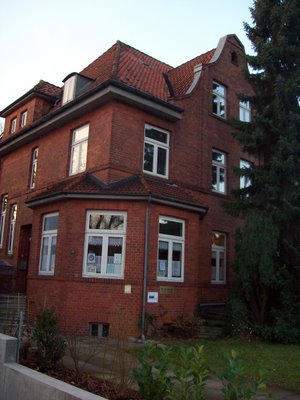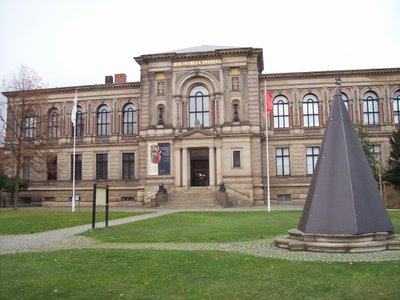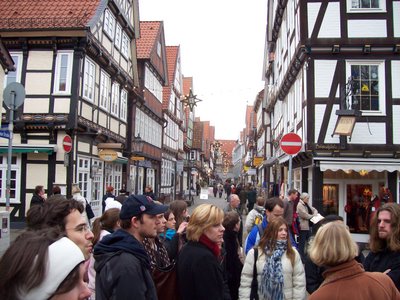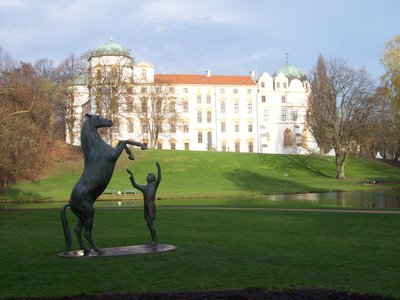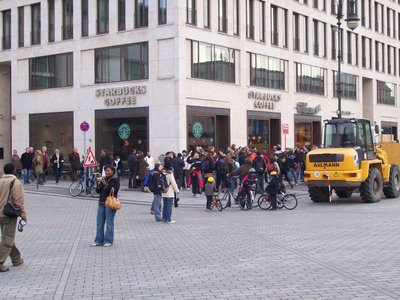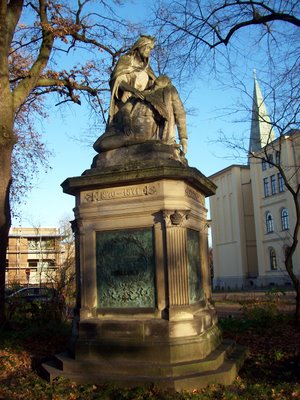
My adventures in Deutschland have caught the attention of two journalists in the Queen City, Rachel Richardson, a former RWC student who now works as an internet editor for the Enquirer, and Rich Shivener, a reporter for the Community Press. Below are links to the pages and below that is the full version of my responses to Shivener's questions. Above is a photo of the memorial in a Lueneburg city park to the dead of the Franco-Prussian War, the German war off unification in 1871. It was in the news, too, back in the 1870s.
http://rodeo.cincinnati.com/getlocal/gpstory.aspx?id=100044&sid=104756http://news.communitypress.com/apps/pbcs.dll/article?AID=/C2/20061116/NEWS01/611160409/Q: How did the idea of this academic, overseas affair come about?
A: This program is part of the University Study Abroad Consortium (USAC), based at the University of Nevada-Reno, and the University of Cincinnati is a member of the consortium. Because of that, UC faculty are able to apply for a variety of positions around the world and are then selected on a competitive basis from faculty applications from other USAC universities. Germany was a good fit for me because of my teaching experience and my historical expertise.
Q: What classes are you teaching?
A: I am teaching two upper division courses - one on the History of World War II and another on the History of the Cold War. These are classes that I teach at UC’s Raymond Walters College. Here in Germany, the USAC program is based at the University of Lueneburg, which is a growing and changing institution of about 10,000 students. When I arrived I had an office in the foreign language department courtesy of the chair who is a New Zealander. My students are from all over the US and I do have students from places as divergent as Australia and Poland.
Q: What's your objective while you're there? A: Germany is an ideal location to teach these courses. My goal is to try to put the students in touch with history in the place where it happened. Here in Germany, remnants and legacies of both the cold war and World War II can still be found. Lueneburg escaped destruction by bombing during the war but many of the other cities visited by students, such as Hamburg, Luebeck, Hannover, Dresden, and Berlin, still bear the scars of war. Some students have traveled to the Normandy beaches and to Bastogne, scene of the Battle of the Bulge. Two former concentration camps are near Lueneburg, Bergun-Belsen and Neurengamme. Visits to Berlin and other places can put the students face to face with the cold war. Lueneburg was a front line city during the cold war and the main campus of the university where our classes are held was actually a base for the British Army. The nearby bridges over the Elbe were mined so they could be destroyed in the event of Soviet attack. I’ve heard local people tell the students of those times and of the days after the collapse of the Soviet Union when crowds of East Germans came to shop in Lueneburg driving their smoky, noisy, little Trabants. These moments are priceless for the students.
Q: Are you a stranger to Germany? A: I’m not a stranger to Germany or to Europe.
Q: If not, how many times have you visited? What compels you to go back? A: Having cousins in England has made visiting Europe easy over the years but beyond that I was in Germany last in 2000 when I visited a friend of mine for a couple of weeks who was teaching at the University of Wittenberg near Berlin. I’ve been to Europe several times since then, twice to teach for RWC’s excellent study abroad program – once to teach a course on the First World War and the second time to teach a course on the Second World War. I keep coming back for several reasons: European culture, the ease of travel, the friendly people, and especially the history. Lueneburg has been a particularly great discovery. It was an important city in the Middle Ages when it was at the center of the salt trade for the Hanseatic League. The wealth of that era can still be seen in the city’s beautiful architecture. Also, I feel comfortable traveling in Europe in part because I was in France and Britain during and after Sept. 11, 2001 and can never forget the warmth and sorrow of the people I met at that terrible time.
Q: What problems have you run into since your arrival? A: I have never really had a bad experience in Europe. Sometimes the language issue is a difficult one but if you are patient and friendly it all works out. Americans just should not expect everyone to speak English. On this trip, I have taken an intensive German language course at the university so I’ve reached a level in which my language skills are somewhat useful. USAC has a very capable and helpful staff here at Lueneburg that has helped make the transition easy. There are some little inconveniences when you travel in Europe. All the stores close at 5 or 6 and don’t open on Sunday so you need to plan a little for food and other items or just get along without. Berlin has just created quite a stir by expanding its shopping hours. Also, many more people smoke here and there are no non-smoking areas in bars and restaurants. I have even seen people smoking while riding their bicycles which seems an odd combination to American eyes.
Q: What do you think students traveling with you are gaining from this trip?A: Obviously, being able to visit the scenes of these important historical events is very valuable. But there are other reasons I think travel is extraordinarily valuable to American students. Frankly, many Americans tend to have very parochial attitudes about the world. Study abroad can open their eyes to other viewpoints and broaden their understanding of the big and complex world beyond America’s shores. Given that the United States will continue to play such an important role in the world, it is really essential for Americans to have a sophisticated understanding of international issues. Often, other peoples oppose American policies for completely rational reasons, not because they are anti-American (a belief I often hear in my Blue Ash classrooms). Germans know much more about America and American politics than Americans know about Germany. While the students and I were glued to our laptops watching the recent election results via the internet, numerous Germans stopped to ask about what we thought it all meant. And they have their own opinions, too, and like to talk about politics.
Q: How will this trip affect your teaching back here? A: Travel always has positive impacts on my teaching. Doing research in the archives in London or standing on Omaha Beach in France or at Checkpoint Charlie in Berlin, adds depth and complexity to my understanding of historical events. This trip, in particular, has brought home to me the destruction of the strategic bombing campaign on German cities. I am also learning much about how the Nazis operated in a rather small town like Lueneburg. There is a museum in Berlin for the Stasi, or the East German secret police, and that has brought home to me the experience of people behind the Iron Curtain. Those are things that I will definitely bring back to the classroom. Also, my improved German language skills should help with my historical research in the future and research always enhances teaching.
Q: It's no question that Germany is definitely different than Blue Ash or Raymond Walter's College. What will you miss the most about Germany?A: Obviously, I’ll have to be honest that I will miss the beer! I also like the ability to get along without a car. Everything I need in Lueneburg is within walking distance and the nearby train station can whiz me off to Munich or Berlin. Hamburg, a great city, is only 20 minutes away. Unlike Cincinnati, these cities have subways to make travel in the city easy and quick. No fighting the traffic on I-275 or hunting for parking places. Also, many Germans of all ages ride bicycles, a very practical and healthy mode of transport. In every German city I have visited, there are bicycle paths marked out on the sidewalks and the bikers definitely have the right-of-way. By contrast, riding a bicycle in the Cincinnati metro is dangerous. Most of all, I am going to miss the students I have met here, both German and American, as well as other Germans who have been so helpful to me.









